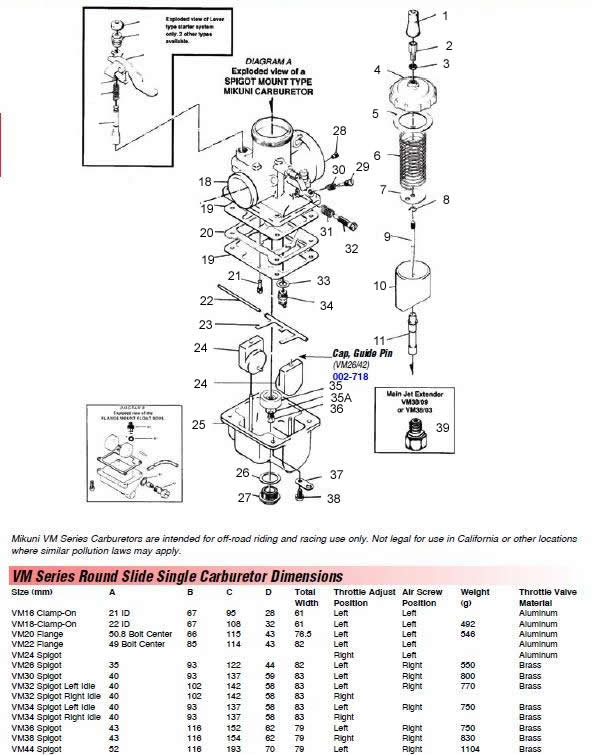Mikuni Bs34 Carburetor Manual
It is normal to have some climb in idle rpm as the bike warms. After i shut off the enrichener all the way (choke) and the bike is still cool having just run for a couple of minutes, it will idle around 1000rpm. After it warms up, it will vary from 1200-1400 rpm (give or take)- and there is nothing wrong with that. Prezi desktop pro full version serial keycrack windows 7.
An idle up around 3000 rpm if everything is adjusted indicates a lean condition from adjustment, air leak or idle circuit passages being dirty. I would turn the idle mixture out to 3.5 turns, make sure there is free play on the throttle cable, good plugs properly gapped, just let it idle to warm, then use the idle air screw to adjust to 1200 rpm. If the idle still climbs too high, then check for air leaks. If there are none, the carbs need cleaning. BTW- the idle air screw should have a spring on it which will prevent it from loosening, If not, get one.
Also, if it is vibrating loose, the idle will get lower.
This must be done first - before moving on to the other tuning ranges. Stock replacement needle jets / emulsion tubes for 36mm and 38mm Mikuni carbs. Mikuni BS (CV) Carburetor Rebuild Tutorial Remove pilot jet plug (replace if petrified) The pilot jet is located down in the recess tunnel under the plug.
Can anyone please provide me a detailed diagram showing ALL the air and fuel circuits/paths for my BS34 carbs (1982 KZ1000P1)? I want to clean them and make sure all passages are open; for example, there are three tiny holes by the butterfly which I'll try to stick some fishing line through, but it would be nice to know where it's suppose to come out. Free download autocad land desktop 2009 full version 64 bit. I downloaded but don't know if it's my carb. And I have two service manuals but they seem to show generic/major paths only. Please or to join the conversation. May I suggest going ahead & doing the complete teardown so that the carb bodies can be soaked. Doing so should take care of any problem orifices that might be plugged.
Doing so isn't that bad. A lot of the same thing is done four times & most stuff only goes back together one way.

I did a set of VM carbs for the first time several years ago, and it really seemed quite easy to me. Instead of bothering w going back-n-forth referencing the manual, I just used my eyeballs & common sense to get them apart. A clean work area is helpful & 4 small parts containers are goood for keeping things organized. Please or to join the conversation. JMKZHI wrote: May I suggest going ahead & doing the complete teardown so that the carb bodies can be soaked. Doing so should take care of any problem orifices that might be plugged.
Doing so isn't that bad. A lot of the same thing is done four times & most stuff only goes back together one way. I did a set of VM carbs for the first time several years ago, and it really seemed quite easy to me. Instead of bothering w going back-n-forth referencing the manual, I just used my eyeballs & common sense to get them apart. A clean work area is helpful & 4 small parts containers are good for keeping things organized.The reason I'm taking the carbs off again (just had them off) is that I didn't put back the pilot jet plugs; but the bike started great and ran great.until the combination of over 1/2 throttle over 4,000 rpm; then it would start coughing and slow down; if I backed off the throttle it would be fine up to red-line.
So I'm going to put the jet plugs back (when they arrive on Thursday), but I figured I would do are more thorough cleaning job; however, in that the bike ran pretty good aside from what I think is the plug issue, I'm not looking to max out on the tear down; mistake? Please or to join the conversation. There is a default setting that I'm not certain of. You can start at 1 1/2 turns out to begin tuning. If the float heights are set properly and everything is clean, the # of turns should be very close. With the bike good and hot, and carbs synced properly. Turn ALL THE PILOT SCREWS either in or out 1/2 turn and listen to the idle.
The idle should noticably rise or fall. Continue turning if the idle rises, turn the other way if it falls. The idea is to find the spot at which the idle is highest. Then, turn each one individually 1/4 turn either in or out and listen.